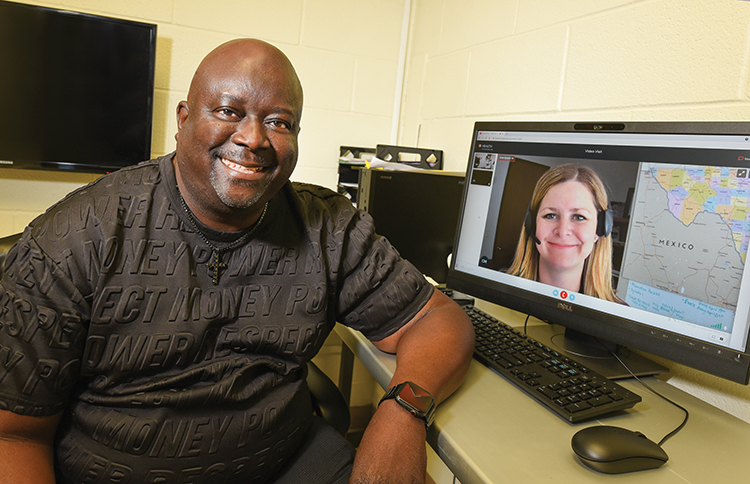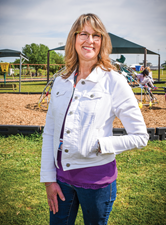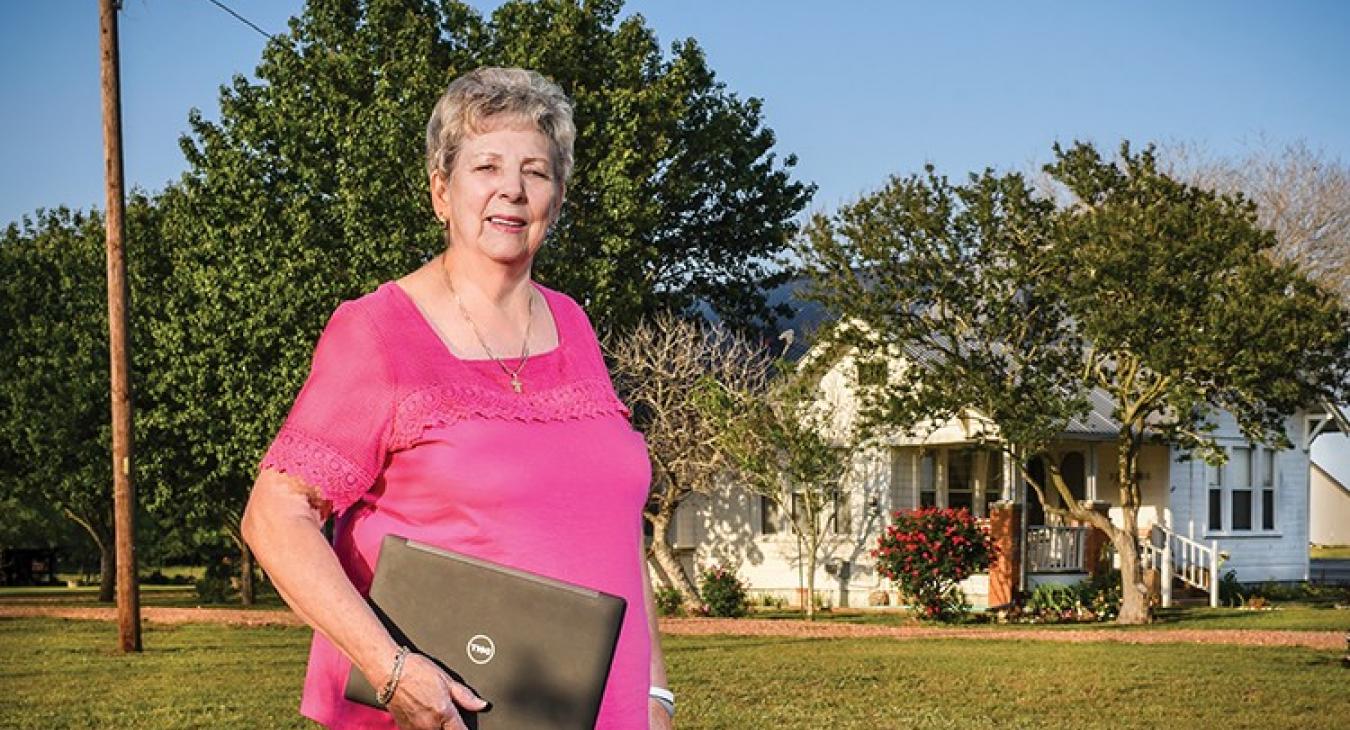Bluebonnet member Clarice Schneider has appreciated being able to make virtual doctor visits from the comfort of her home in Lincoln. (Sarah Beal photo)
By Mary Ann Roser
In December 2019, Clarice Schneider had a procedure for an irregular heartbeat in Houston, where she was living. Later that month, she and her husband moved to a new home in Lincoln in Lee County.
To stay on top of her heart health, she connected with a cardiologist in Bryan- College Station, about an hour away, and saw him for the first time in April 2020. But then the COVID-19 pandemic worsened, instead of fading, and that changed everything.
Her new cardiologist was advising patients not to come into his office. Schneider still needed follow up care, and COVID-19 posed a serious threat to her. “I was scared to go outside,” said Schneider, who is retired. What to do?
Without leaving home, she joined millions of Texans who, for the first time, used a phone, tablet or computer to visit a health care provider. In Schneider’s case, the virtual visit with her new Baylor Scott & White cardiologist in Bryan-College Station was by phone. In less than 10 minutes, she answered his essential questions about her blood pressure — she was taking it at home and it was normal — and whether she still was experiencing heart palpitations — she wasn’t. She felt assured that she was healing well.
Call it telehealth, telemedicine or virtual care: The pandemic loosened restrictions around these visits, allowing audio-only calls, more kinds of health care professionals to engage in telehealth and more circumstances under which Medicare patients could take part, among other things. Now doctors and other providers could be paid for a variety of virtual appointments.
“The cat is out of the bag,” Dr. Ashis Barad said. The pediatric gastroenterologist is also medical director of virtual specialty care services for Baylor Scott & White Health. Before the pandemic, his system’s telehealth visits were about 1 percent of their total outpatient visits. The week of April 6, 2020, at the height of the response, telehealth had skyrocketed to 72 percent of visits.
Now, virtual visits are holding steady at about 11 percent of all outpatient encounters at Baylor Scott & White.
“Where you live, your ZIP code, is the biggest factor in your health care outcomes,” said Barad, who is based in Temple. “The beauty and potential of telehealth is geography shouldn’t matter.”
Since 2020’s telehealth tsunami, use of the technology has ebbed, but no one expects it to recede to pre-COVID-19 levels. Patients say they appreciate the simplicity, safety and convenience. Schneider expects to continue virtual appointments for routine matters.
“My first visit was 8:15 in the morning, and I didn’t have to get up and drive to Bryan-College Station,” Schneider said of the initial phone session with her cardiologist.
Having the telemedicine option has been “very comforting” during the pandemic, she said, adding that she still hopes to meet in person with her cardiologist and her primary care physician in Brenham at least once a year.
Fewer hospitals, doctors
Rural residents have long grappled with shortages of medical providers and mental health professionals. COVID-19 underscored that inequity. A primary reason is a lack of rural hospitals.
Texas has seen more hospital closures than any other state. Since 2010, 27 rural hospitals in 22 communities have shuttered, according to John Henderson, president and CEO of the Texas Organization of Rural and Community Hospitals, known as TORCH. The state has 158 remaining rural hospitals, and over half of those — 82 — are at high risk of closing, according to a recent report from the federal Center for Healthcare Quality and Payment Reform. The primary reasons cited are cuts in Medicare and underpayments from Texas Medicaid.
Unfortunately, when a hospital goes, so do specialists and other health care providers.
When access to care declines, “people put off care and become very ill,” Barad said. He has telehealth visits with children across Texas because of a shortage of pediatric GI specialists. “People getting admitted to hospitals are sicker,” he said, and expensive emergency departments get overused.
Telehealth has helped expand access to care across the state’s rural areas.
By May 2020, 4.5 million Texans had made their first telehealth visit, according to Mark Olney, a Dallas-based managing director at Accenture, a global professional services and consulting company. These first-timers were more than double the number of pre-pandemic telehealth users, Olney said. With many clinics and offices closed to in-person visits, it was the only option for many.
Now Olney is seeing telehealth startups emerging to help people manage chronic health conditions.
Roy Lehmann of Luling said one of his daughters hurt her back this spring and was not up for a long car ride. Instead, they used a cell phone for a telehealth visit with physician assistant Karina Rea, who is the primary care provider for Lehmann’s daughter. Rea works with Ascension Seton on its Children’s Care-a-Van, a specially equipped RV that is on the road in Caldwell County, Tuesdays through Fridays, stopping one day each in Luling, Lockhart, Prairie Lea and Dale. The van was not in Luling the day the Lehmanns needed an appointment, but telehealth made it possible.
“Using telehealth made it much easier for us because we didn’t have to drive to Lockhart or Prairie Lea,” said Lehmann, a truck driver. And he didn’t have to miss a half day of work.
During the pandemic, Care-a-Van providers encouraged telehealth visits, when possible, to protect patients, family and staff from COVID-19 infection. The mobile facility’s patients range from newborns to 18-year-olds from across Caldwell County. Even now, although the moving health facility that began operations in 2003 is fully operational, a virtual visit may still the best option.
“It’s an indispensable technology and a game changer for access to care,” said Henderson, of TORCH, about telehealth. “Before the pandemic, I saw telehealth provide rural communities access to specialty physician services. But out of necessity, the pandemic has applied that to primary care.
“There’s just not going to be any going back.”
One-stop shop
Before the pandemic, rural residents needing a specialist, including a mental health professional, might have had to take the day off work or school to make what might often be a long trip. Others would go to a hospital or clinic closer to home and sit in front of a screen to communicate virtually with a specialist or therapist.
That’s the model Faith Mission & Help Center started back in 2013 when people receiving primary care at its Brenham clinic or social services at the mission needed psychological counseling. People still use Faith Mission’s interactive screen for visits, but the pandemic enabled many to get care from home, whether with a local provider or one farther away, Randy Wells said. He is executive director of Faith Mission and administrator of the Washington County Health & Service Center. The center provides non emergency health services, medication and counseling in partnership with the city of Brenham, Washington County, Baylor Scott & White, private providers and Texas A&M University.
For many in the community, it is a one-stop shop for care.
Wells collaborates with Carly McCord, director of telebehavioral health at the Texas A&M College of Medicine, to expand community access to mental health counseling. Over half of the state’s 254 counties are without a single psychologist or psychiatrist, McCord said. And two-thirds of all of the psychologists and psychiatrists in Texas work in the five largest cities, she added.

(Sarah Beal)
McCord and Wells have spoken at state and national conferences about their successful collaboration. “It’s the only … model like it in the country,” Wells said with pride.
Before COVID-19 struck, about 90 percent of the mental health patients assisted by Texas A&M in Washington County went to the therapist’s office or clinic for counseling, while 10 percent had a telehealth visit. The pandemic reversed those numbers, McCord said.
“Telehealth brings the provider to the community,” she said. She is training the next generation of psychologists — graduate students working on doctorates to work with rural residents.
“We rolled out telehealth in 130 schools, covering almost 65,000 lives,” McCord said of A&M’s role.
Wells hopes the privacy of telehealth and the mental health difficulties that the pandemic has stoked will reduce the stigma around seeking help.
“You could be depressed and under the covers in bed, but you can still get counseling from the comfort of your home,” he said.
Wells sees room for growth and hopes more businesses will embrace telehealth to keep people on the job and functioning without slipping into a crisis. “We still have a lot of work to do,” he said.
Counseling the kids
Children and adolescents have not been left out of the telehealth trend.
Schools, partnering with university health centers, are jumping in to fill a yawning gap in mental health services for students, some of whom have experienced pandemic-related anxiety and depression. Fortunately, the Texas Legislature in 2019 provided money to launch the Texas Child Health Access Through Telemedicine program as part of the new Texas Child Mental Health Care Consortium. The consortium, administered by the University of Texas System, includes Texas’ 13 state-funded health-related institutions of higher education. They provide psychiatrists, therapists and doctoral students to help children and adolescents while they’re in school.
At Caldwell Elementary School in Burleson County, Beverly Lilie is the only counselor for the school’s 550 pupils in pre-kindergarten through third grade. She has trained teachers how to identify students who could benefit from the telemedicine program, and if the parents agree, the child receives four free telehealth counseling sessions, plus an intake visit. Students needing longer-term care receive referrals to therapists.

“It’s been absolutely wonderful,” Lilie said. She now has an effective, convenient way to help struggling children. “I like that they are communicating with the parent and give the parents ideas and suggestions” on helping their child.
Because the students in her school are so young, Lilie wondered how well they would adapt to working with a counselor on a screen. She has been pleasantly surprised.
“They all, within a short period of time, built a relationship with that person and really looked forward to seeing them,” Lilie said. “Some of them were sad when they were told it was their last session.”
An old-school graduate
Before the pandemic spread telehealth, many doctors were skeptical.

Dr. Karen Smith, a family medicine physician with Baylor Scott & White in Manor, describes herself as an “old school, paper-and-pencil” doctor who was not “gung ho about pushing on the edges of technology.” She rarely had telehealth appointments with patients before COVID-19’s arrival.
The pandemic was like switching on a light. With her clinic suddenly closed to in-person care, all of Smith’s visits in the early days of the pandemic were by telehealth, 12 to 14 a day, she said. “It was amazing how fast it changed,” she added. “We barely missed a beat. It was a huge switch and . . . it pushed us forward.
“It was a relief I could still take care of my patients.”
One of her patients is Manor school board president, Realtor and pandemic relief volunteer Monique Celedon. When Celedon fell ill in 2020 with COVID-19, she went to the clinic but was too sick to get out of the car. Staff came to her in the parking lot. Celedon soon discovered that with telehealth she could have follow-up visits with Smith from home.
“I would recommend this to anyone, unless you have an emergency situation,” Celedon said.
She doesn’t plan to go back to inperson visits only because telehealth has made it possible for her to maintain a busy work-and-volunteer schedule. She is more likely to keep telehealth appointments and believes virtual appointments have made it possible to better manage her diabetes.
“My sugar levels have gone down, and it’s really changed the way I see doctor appointments,” Celedon said. “I have been paying more attention to my health and it’s just so simple. . . . My hope is more physicians will provide this sort of service and more people would continue to use it.”
Smith, who now sees about three telehealth patients a day, has found that she also likes seeing her own doctor that way. “I love it,” Smith said, “and I don’t have to miss work.”
But sometimes, nothing but an in person visit will do, Smith said. “It means something to be eyeballed by a doctor. You can tell if someone is jaundiced, if they are having trouble breathing.”
Barriers to telehealth
The extent of post-pandemic telehealth depends largely on whether health insurers and government programs continue to cover the costs. They may require the patient be seen on a screen. Would a phone call still be OK?
“We certainly hope that the current momentum for increased use of telehealth services will be sustained,” said Dr. Jeffrey Newport, chief of women’s postpartum mental health at UT Health Austin.
The Women’s Reproductive Mental Health Clinic he oversees provides psychiatric care to women in the weeks before and after childbirth. The clinic serves the Austin area as well as East Texas, North Texas and the Panhandle, Newport said.
In many rural areas, spotty high-speed internet access impedes online telehealth.
“In a rural market, a lot of people don’t have smart phones or (internet) connectivity. Some have to drive to a grocery store or restaurant for that,” said Denise Watson, an Ascension Seton nurse who directs the health system’s rural clinics. Lack of high-speed internet “is the main issue we have.”
A July 2020 report by the Texas Governor’s Broadband Development Council says an estimated 926,859 Texans lack access to high-speed internet, or broadband, at home. “This is particularly problematic for those who need to attend school virtually, visit a doctor online, or work remotely, either due to the COVID-19 pandemic or other factors,” the report says.
Solving that issue and the reimbursement question are critical, said Henderson, with TORCH. “When I think about the future of rural health, it's not going be as inpatient-focused; it's going to be more outpatient care, with a lot more technology.”
Mari Robinson, director of telehealth at the University of Texas Medical Branch at Galveston, is hopeful about the future of virtual care and the promise it holds for rural Texans. She is coordinating a statewide telehealth system, the UT Virtual Telehealth Network, that leverages the power of UT’s eight health science centers and medical schools to expand health care services in rural and remote areas.

“The pandemic has really shown people you can use this technology, and it’s OK to use it beyond screening for COVID,” Robinson said. “I’m very optimistic this is an opportunity to get really good-quality medical care to underserved areas so folks can form good, long-term relationships with the specialists they need. They can use telemedicine, when it’s appropriate — and that’s really exciting — and they can go and see the specialist when they need to.”
Just like Clarice Schneider discovered.
KEEPING THE CARE-A-VAN ROLLLING
Since 2003, a custom RV converted into a mobile medical unit has provided essential medical care to children and adolescents in mostly rural Caldwell County. The Ascension Seton Edgar B. Davis Care-a-Van is funded by donations from community residents, businesses and grants. Bluebonnet Electric Cooperative has been a supporter since 2008.

Services include well visits, vaccinations, minor acute visits and physicals. During the pandemic, the Care-a-Van has incorporated telemedicine into their services. Over the years, a small team has provided service to an estimated 24,000 young people from Caldwell County, many of whom are uninsured or underinsured. A lack of primary care physicians in the area has made the Care-a-Van an essential source of accessible, affordable health care. The Seton Hays Foundation is working to create a $1.5 million endowment for the van to provide medical care for generations to come.
The van pulls into different Caldwell County communities every week. Call 512-738-0625 to schedule an appointment. For news and updates, go to their Facebook page.
Download this story as it appeared in the Texas Co-op Power magazine »





